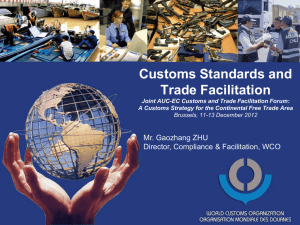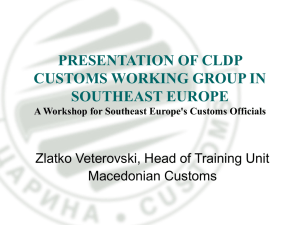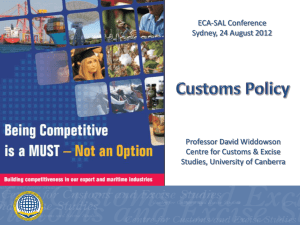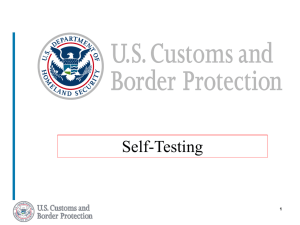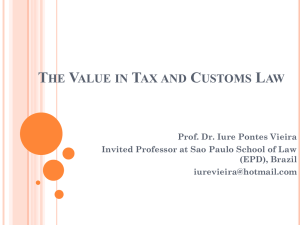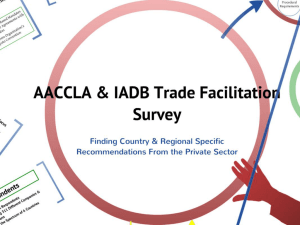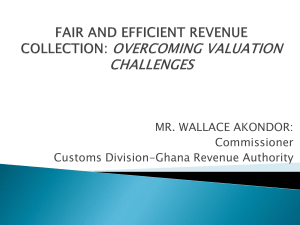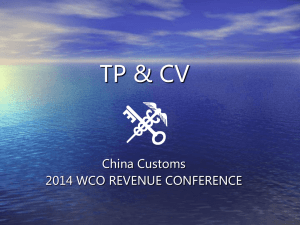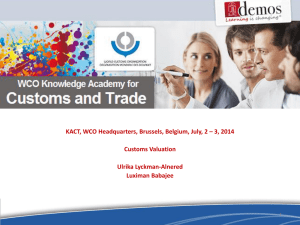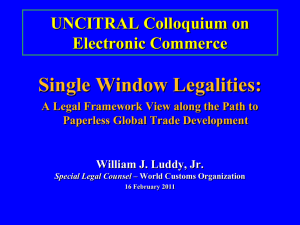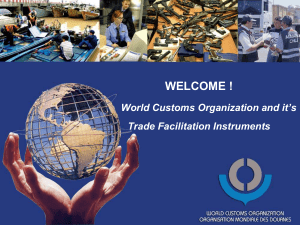WCO - CIAT 2013
advertisement
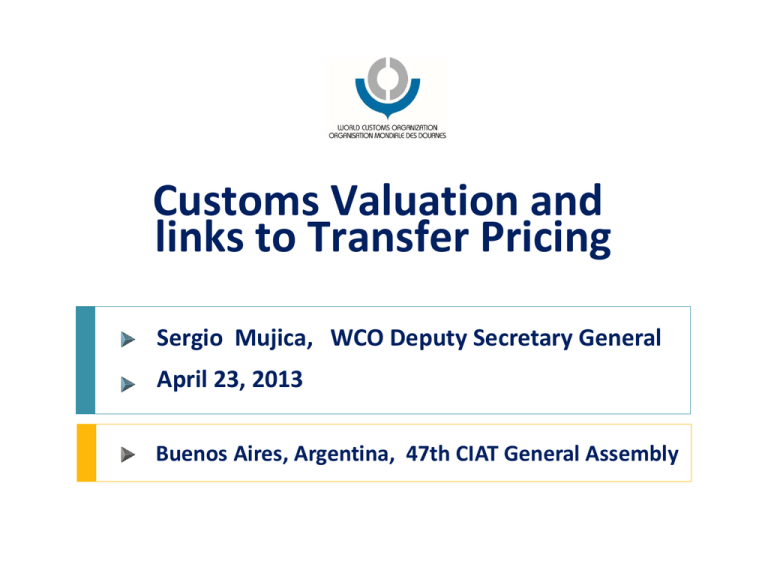
Customs Valuation and links to Transfer Pricing Sergio Mujica, WCO Deputy Secretary General April 23, 2013 Buenos Aires, Argentina, 47th CIAT General Assembly Today’s Agenda A quick view of WCO Article VII GATT: Basic principles WTO Valuation Agreement Comparison with OECD TP Guidelines Activities to date and way forward World Customs Organization (WCO) Exclusively focused on Customs matters Global Membership: 179 countries Representing 98% of global trade WCO Mission To enhance the effectiveness and efficiency of Customs… Trade Facilitation and Security Protect society Collect fiscal revenue ...which promotes Economic prosperity and social development l WCO Objectives …to secure the highest degree of harmonization, standardization and simplification of Customs systems WCO Objectives …to provide a platform for international cooperation TAX STATISTICS TRANSPORT WCO LAW ENFORCEMENT HERITAGE ENVIRONMENT HEALTH STANDARDS DEVELOPMENT ENDANGERED SPECIES WCO Objectives …to provide Capacity Building Article VII of GATT Basic Principles Based on ACTUAL value of the imported merchandise Where not ascertainable (e.g. no sale), use nearest ascertainable equivalent value It must NOT be based on arbitrary or fictitious values Actual value may be represented by … …invoice price WTO Valuation Agreement (I) Primary basis for customs value is “transaction value” = price actually paid or payable plus certain adjustments (e.g. certain commissions and royalties) Transaction value to be used to “greatest extent possible” Typically, developed countries use transaction value for 90-95% of all importations WTO Valuation Agreement (II) The Agreement provides a hierarchy of alternative methods to be used when transaction value cannot be used (e.g. no sale) The Agreement also contains a number of trade facilitation provisions All WTO Members are obliged to implement the provisions of the Agreement in national law and apply it at the practical level WTO Valuation Agreement (III) Where parties are related, the declared price can be accepted as long as the relationship did not influence the price. The Agreement provides two options for testing this: Test values Examine “circumstances of sale” OECD Transfer Pricing Guidelines Comparison with WTO Valuation methodology OECD methodology WTO Valuation methodology Traditional transaction Methods: Comparable Uncontrolled Price (CUP) Resale Price Method Identical and similar goods method (Article 2 & 3) Deductive value method (Article 5) Cost-plus Method Computed value method (Article 6) Profit Methods: Transactional Net Margin Method Profit Split Method Key Differences Customs Valuation Transfer Pricing Goods only Goods, services & property Transaction based Based on aggregates/annual Confirmed at point of customs clearance Confirmed retrospectively (some years after event) Mandatory hierarchical order of alternative methods Allows choice of the most appropriate method Application of WTO Agreement is mandatory Supported by international guidelines; not mandatory This makes comparison of Customs values and transfer prices very difficult Competing tensions Customs authority objective Direct Tax authority objective Ensure all appropriate elements are included in the customs value Ensure the transfer price does not include inappropriate elements Pull in opposite directions Trade objective Trade objective In general, to minimise Customs value = reduced duty liability In general, to maximise transfer price = reduced taxable profit What is the issue for Customs? Key questions: To what extent, if at all, can a transfer price study be accepted as the basis for a customs value? How should post-importation adjustments be dealt with? Commentary 23.1 Examination of the expression “circumstances surrounding the sale” under Article 1.2 (a) in relation to the use of transfer pricing studies First text of the TCCV to refer to transfer pricing Key questions: Has price been settled in a manner consistent with the normal pricing practices of the industry? Is price adequate to ensure recovery of all costs plus a profit representative of the firm’s (seller’s) overall profit realized over a ... period of time? Acknowledgement that a TP study may be of use in examining a related parties transaction Activities to date … and way forward Two joint WCO/OECD conferences - 2006, 2007 On agenda of Technical Committee on Customs Valuation (TCCV) since 2007 TCCV produced Commentary 23.1 in 2010 Scheduled next steps: WCO continues to work on the issue with OECD and with business Two joint WCO/OECD workshops in 2013 to provide training and awareness-raising to both Customs and tax officials WCO will attend OECD’s relevant meetings and vice versa Cooperation is indispensable… Thank you Sergio.Mujica@wcoomd.org
